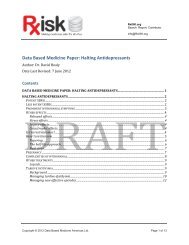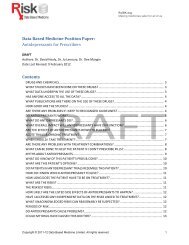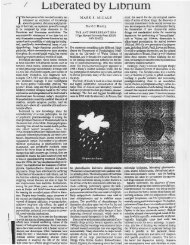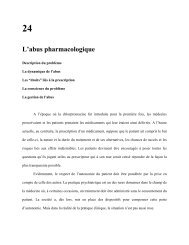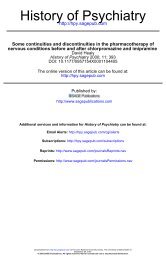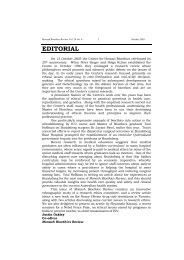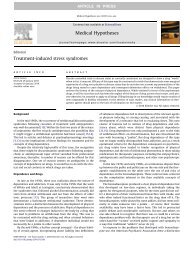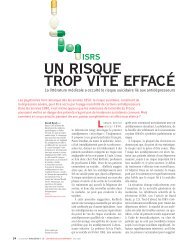The enhancement of social functioning as a ... - Dr. David Healy
The enhancement of social functioning as a ... - Dr. David Healy
The enhancement of social functioning as a ... - Dr. David Healy
You also want an ePaper? Increase the reach of your titles
YUMPU automatically turns print PDFs into web optimized ePapers that Google loves.
s26serotonergic systems are both effective antidepressants, thetraditional response h<strong>as</strong> been to invoke a final commonpathway in p-receptor downregulation or 5-HT2 receptorchanges, implicitly locating the 'lesion' in these receptorsrather than specifying any functional consequences that mightstem from receptor alteration.An alternative response h<strong>as</strong> been to postulate the notion <strong>of</strong>noradrenergic or serotonergic depressions with the implicationthat if the neurobiological status <strong>of</strong> particular patients couldbe pinpointed then the selection <strong>of</strong> the appropriate drug wouldenhance the chances <strong>of</strong> therapeutic success. On this b<strong>as</strong>is, agood deal <strong>of</strong> research h<strong>as</strong> been directed towards determiningwhether some individuals are 'noradrenergic deficient', <strong>as</strong>indicated by levels <strong>of</strong> 3-methoxy-4-hydroxyphenylglycol(MHPG) and other catecholamine metabolites, or'serotonergicdeficient', which, it is <strong>as</strong>sumed, will be revealed by evidence<strong>of</strong> reduced serotonin turnover in the form <strong>of</strong> lowered CSF 5-HIAA (<strong>Healy</strong>, 1987; Montgomery et al., 1987; <strong>Healy</strong>, 1997;'Montgomery, 1997). To date, neither efforts to distinguishdifferent biochemical depressions nor to boost therapeuticresponses by targeting those who have low levels <strong>of</strong> one orother neurotransmitter with an appropriate agent, h<strong>as</strong> bornefruit. Moreover. the affective disorders have never looked likethe inborn error <strong>of</strong> metabolism disorders that the above view<strong>of</strong> their nature would imply.Implicit in these approaches is the notion that antidepressantsare 'magic bullets' and therefore there is no need tospecify any indirect functional changes, whether behaviouralor physiological, that they need to produce in order to bringabout recoveries. An alternative way <strong>of</strong> viewing thesecompounds is that, currently, we possess a variety <strong>of</strong>antidepressant principles or perhaps, more broadly speaking,anti-nervousness principles. If the nature <strong>of</strong> these principlescan be specified more closely, it may allow us to deploy ourtherapeutic armamentarium more rationally.Indeed, adopting this approach, it is possible to turn theargument about noradrenergic and serotonergic depressionsaround entirely and to suggesthat it is expected that drugswhich'are active on the noradrenergic system would not workproperly if there were abnormalities <strong>of</strong> the noradrenergicsystem. Equally, drugs active on the serotonergic system wouldbe le<strong>as</strong>t likely to work effectively in the presence <strong>of</strong>abnormalities <strong>of</strong> that system. This argument is similar inform to the proposal that <strong>as</strong>pirin or other non-steroidal antiinflammatorydrugs would be le<strong>as</strong>t effective for arthriticconditions in individuals who had disorders <strong>of</strong>the prostaglandinpathways on which these agents act. On this b<strong>as</strong>is, it mightbe argued that medications which are selective to a particularsystem are likely to be either ineffective or toxic to individualswith abnormalities <strong>of</strong> that system. Some indications <strong>of</strong> possibleoutcomes can be deduced from recent data presented byBrunner et al. (1993) on abnormal behaviour in individualswith monoamine oxid<strong>as</strong>e deficiencies.A consideration <strong>of</strong> the therapeutic possibilities <strong>of</strong> <strong>as</strong>pirinpoints to the fact that it can be anti-inflammatory, anti-pyreticand antithrombotic. Its useful deployment in clinical situationsdepends on understanding the nature <strong>of</strong> these actionsrather than relying on the fact that <strong>as</strong>pirin acts onprostaglandin synthesis. What functional outcomes are therefrom actions on the noradrenergic or serotonergic systems?D. HEALYAND T. McMONAGLEIn the field <strong>of</strong>personality biology, it h<strong>as</strong> been traditional tosuggesthat the noradrenergic, dopaminergic and serotonergicsystems have differing functions. A number <strong>of</strong> schemes havebeen produced (Cloninger, 1986; van Praag,1992). Accordingto most schemes, noradrenaline is particularly important invigilance, serotonin in the regulation <strong>of</strong> impulse and irritability,and dopamine in the regulation <strong>of</strong> drive (Fig. l).If this scheme is followed, it becomes possible to suggesthatdrugs which act on the serotonergic system have an antiirritabilityaction <strong>of</strong> some form. This action might be expressedby a physician to a patient enquiring what the drug will do interms such <strong>as</strong> 'it will make you sanguine'. This type <strong>of</strong> actionwill be 'anxiolytic' but it might be expected to provide adifferent type <strong>of</strong> anxiolysis to the anxiolysis, for example, thatstems from the muscle relaxation provided by benzodiazepines.Benzodiazepines, in addition to other central actions, inhibitthe feedback loop from muscular tension to mental state. This<strong>of</strong>fers a therapeutic principle that can be expected to be useful insome but not all anxiety states. An action to reduce irritability<strong>of</strong>fers a quite different therapeutic principle that might beexpected to have benefits across a range <strong>of</strong> psychosyndromes,including some anxiety-b<strong>as</strong>ed and some depression-b<strong>as</strong>eddisorders. <strong>The</strong> drugs, in effect, may be operating to makesomeone sanguine, and where they are effective it may bebecause the introduction <strong>of</strong> sanguinity provides a space forother homeostatic mechanisms to come into play, which in turnpromote a resolution <strong>of</strong> the index disorder.While the monoamine hypotheses <strong>of</strong> the affective disordersembodied an implicit 'magic bullet' concept <strong>of</strong> the action <strong>of</strong>antidepressants, the idea that these drugs might contain anumber <strong>of</strong> different therapeutic principles had been adumbratedby Kielholz (1968) and Carlsson (Carlsson et al., 1969;Carlsson, 1982) amongst others. <strong>Dr</strong>ugs such <strong>as</strong> desipramineand nortriptyline were recognized to be more drive-enhancingthan agents like clomipramine, which appeared to be doingsomething else. When the differing effects <strong>of</strong> these agents oncatecholamine and serotonergic systems became clearer, itbecame obvious that there w<strong>as</strong> a c<strong>as</strong>e for synthesizing the firstSSRI, zimelidine, in the hope that a more selective action onthe serotonergic system would underpin some other functionaleffect in mood disorders.In the c<strong>as</strong>e <strong>of</strong> drugs active on the noradrenergic system,there is a cons€nsus that these agents act on drive and vigilanceto a much greater extent than drugs active on the serotonergicsystem. In so far <strong>as</strong> they do, they would target different <strong>as</strong>pects<strong>of</strong> the depressive syndrome to the SSRIs. Equally though,through what may be characterized provisionally <strong>as</strong> an antianergicaction, this may impact on the disorder so thathomeostatic mechanisms can come into play to promote awider resolution <strong>of</strong> the condition. If something similar to thisscenario is correct then one might expect more severe forms <strong>of</strong>depression, in which psychomotor retardation is frequentlymore pronounced (Parker and Hadzi-Pavlovic, 1996; Sobinand Sackheim, 1997), to be more likely to respond to theseagents. <strong>The</strong>re are a series <strong>of</strong> recent studies on reboxetine(Berzewski et al., 1997; Dubini et al., 1997a), milnacipram(Lopez-Ibor et al., 1996) and mirtazapine (Wheatley andKremer, 1997), which all point to the fact that an action on thenoradrenergic system does confer benefits in the management<strong>of</strong> severe depression.
ENHANCEMENT OF SOCIAL FUNCTIONINGs27NORADRENALINEFigure ISchematic representation <strong>of</strong> different <strong>as</strong>pects <strong>of</strong> <strong>functioning</strong> attributed to noradrenaline, serotonin and dopamine'cocktailThis analysis does not suggesthat the use <strong>of</strong> these agentscompounds', involving polypharmacy within theshould be restricted to severe depression, merely that different one compound.therapeutic principles can be employed in different clinical If there is no 'central' mechanism in depression that is thesituaiions. A further possibility is that mild to moderate target for 'magic bullets', but rather a variety <strong>of</strong> psychophysioiogicalfunctions that we can modify to facilitate thedepression characterized by lack <strong>of</strong> energy or complaints <strong>of</strong>being 'tired all the time' may be more likely to respond to restoiation <strong>of</strong> homeost<strong>as</strong>is, perhaps one <strong>of</strong> these otheragenis like reboxetine, which are active on noradrenergic functions might be amenable to modification' even by nondruginterventions, with equal therapeutic effect' A re-rather than serotonergic systems. Support for this conceptcomes from the <strong>social</strong> <strong>functioning</strong> data that demonstrates that evaluation <strong>of</strong> antidepressant actions in terms <strong>of</strong> distinctreboxetine h<strong>as</strong> a stronger effect on active <strong>social</strong> behaviour (e'g' therapeutic principles therefore opens up the possibility thatgregariousness, community involvement) than fluoxetine a number <strong>of</strong> other approaches, including cognitive, interpersonalor behavioural therapies, may also be considered to <strong>of</strong>ferio"tlni et al., 7997a,b). Conversely, compounds active onihe serotonergic system may be more useful in some c<strong>as</strong>es <strong>of</strong> certain therapeutic principles, which may be complementary toanxious deprission. On the b<strong>as</strong>is that both groups <strong>of</strong>fer a pharmacotherapeutic interventions. Indeed, the possibilitytherapeutic principle in depression rather than just in some must be considered that these non-pharmacotherapeuticdepressions,-both would be equally effective for the majority <strong>of</strong> interventions may exert some <strong>of</strong> their effects through ac<strong>as</strong>es <strong>of</strong> depression. Depression, like ulcers, is a trap and <strong>as</strong> mobilization <strong>of</strong> biological processes.with any trap there may be a number <strong>of</strong> ways out and the wayout need not involve retracing the path <strong>of</strong> entry'If the possibility that current antidepressants <strong>of</strong>fer a numberSocial <strong>functioning</strong> in dePression<strong>of</strong> therapeutic principles is accepted, further possibilitiesfollow. ihe broad idea <strong>of</strong> actions on noradrenergic or Following the introduction <strong>of</strong> the antidepressants and monoaminehypotheses <strong>of</strong> depression, there w<strong>as</strong> an <strong>as</strong>sumption thatserotonergic systems can be expanded further' In the chse <strong>of</strong>agents like mirtazapine, for example, there may be more than antidepressants, in 'magic bullet' f<strong>as</strong>hion, corrected the coreone action on the serotonergic system - an agonist action on featuris <strong>of</strong> the illness and, for a while, it seemed quixotic to5-HTlu receptors and an antagonist action on 5-HTt receptors' even consider treating a biological disorder like depressionThis iin be construed either in terms <strong>of</strong> blockade <strong>of</strong> 5-HT2 with a psychotherapeutic intervention' This divide betweenreceptors enhancing the efficiency <strong>of</strong> the action <strong>of</strong> the drug on pharmaio- and psychotherapeutic approaches to the affective5-HTl" receptors (i.e. there is only one therapeutic principle disorders began to yield, however, to work from YalemvoGd) or alternatively the action on 5-HT1" receptors is an University, USA, carried out by Paykel, Weissman andanti-irritability action while the blockade <strong>of</strong> 5-HT2 receptors Klerman. <strong>The</strong>ir work w<strong>as</strong> influential for two re<strong>as</strong>ons' First,promotes sleep and appetite restoration, both <strong>of</strong> which can be it provided evidence that life events, or environmentalexpected to be therapeutic in depressive disorders' From this dislocations, could trigger c<strong>as</strong>es that, until then, had beenpoint <strong>of</strong> view, many psychotropic agents are in essence termed endogenous depressive disorders, a form <strong>of</strong>depression
s28that w<strong>as</strong> commonly seen <strong>as</strong> arising de novo from a biologicaldysfunction.<strong>The</strong> second set <strong>of</strong> developments resulted in the creation <strong>of</strong>interpersonal therapy (IPT). <strong>The</strong> original idea behind thistherapeutic approach w<strong>as</strong> that in addition to the core disorder,depressive illness, like other medical illnesses, involvesdisturbances in the <strong>social</strong> network and <strong>social</strong> <strong>functioning</strong> <strong>of</strong>the affected individual. Tackling these could be expected toreduce the burden <strong>of</strong> disability, just <strong>as</strong> a similar approach canmake a difference in hypertension, rheumatoid arthritis orother chronic medical conditions. Initially, these ide<strong>as</strong> owedsomething to the thinking <strong>of</strong> Jerome Frank and Hany Stack-Sullivan, but they were developed by Weissman, Paykel andKlerman in the early 1970s (Klerman et al., 1974).<strong>The</strong> initial expectation w<strong>as</strong> that antidepressantreatmentwould improve the core symptoms <strong>of</strong> depressive illness butthat IPT would be shown to enhance <strong>social</strong> <strong>functioning</strong>. <strong>The</strong>first acute study to explore this hypothesis w<strong>as</strong> confirmatory(Klerman et al., 1974; Weissman et al., 1974). This study led tosuggestions that it might be worth testing IPT against the corefeatures <strong>of</strong> depression itself, which led to a subsequent studythat demonstrated an efficacy for IPT against these features <strong>of</strong>the illness (Weissman et al., 1979). This breakthrough led tothe inclusion <strong>of</strong> IPT in the National Institute <strong>of</strong> Mental health(NIMH) randomized trial comparing IPT with imipramineand cognitive therapy in the management <strong>of</strong> depressivedisorders (Elkin er al., 1989). This trial demonstrated aneffectiveness <strong>of</strong> IPT in major depressive disorders and, indeed,a superiority <strong>of</strong> IPT to cognitive therapy, flndings that led toits inclusion in prophylactic studies <strong>of</strong> affective disorders(Frank et al.,1990).<strong>The</strong> findings from the NIMH study, which demonstrated anefficacy <strong>of</strong> IPT in major depressive disorders, clearly support atherapeutic principle <strong>as</strong> opposed to a 'magic bullet' argument.<strong>The</strong> data also support the hypothesis that treatments may beless likely to be effective if the system they act on isdysfunctional. When the NIMH investigators looked at whatpredicted successful outcomes with both IPT and cognitivetherapy, they found that a better <strong>social</strong> situation favoured abetter outcome with IPT while success with cognitive therapyw<strong>as</strong> more likely in the presence <strong>of</strong> fewer dysfunctionalthoughts (Sotsky et al., l99l).To date, therefore, IPT h<strong>as</strong> been shown to enhance <strong>social</strong><strong>functioning</strong> in major depressive disorders and to tackle theacute symptoms <strong>of</strong> the disorder. Accordingly, acting onperceived difficulties in interpersonal function <strong>of</strong>fers atherapeutic principle in the management <strong>of</strong> depression. <strong>The</strong>converse question - whether antidepressant pharmacotherapycan impact on <strong>social</strong> <strong>functioning</strong> in addition to addressing thecore features <strong>of</strong> the illness - h<strong>as</strong> not been closely addressed.One might expect there to be some <strong>enhancement</strong> <strong>of</strong> <strong>social</strong><strong>functioning</strong> simply by virtue <strong>of</strong> ameliorating the core features<strong>of</strong> the illness, but the differential effects found in comparativestudies <strong>of</strong> reboxetine and fluoxetine indicate that somethingmore than simply this may be happening (Dnbini et al.,1997b). Where both agents may produce some <strong>enhancement</strong> in<strong>social</strong> <strong>functioning</strong> simply 6y virtue <strong>of</strong> recovery from theunderlying disorder, reboxetine appears to provide additionalbenefits to the depressed patient. <strong>The</strong> alternative explanationthatfluoxetine, while proving beneficial on core features <strong>of</strong> theD. HEALYAND T. McMONAGLEdisorder, may produce subtle decrements in <strong>social</strong> <strong>functioning</strong>alsoneeds to be considered.<strong>The</strong>se findings open certain possibilities. <strong>Dr</strong>ugs like reboxetinemight complement therapeutic approaches such <strong>as</strong> IPTparticularly well. On a broader front, however, <strong>as</strong> opposed tosimply specifying activation <strong>as</strong> a therapeutic principle, itbecomes possible to propose that reboxetine enhances <strong>social</strong><strong>functioning</strong> or <strong>social</strong> drive me<strong>as</strong>ured by the Social AdaptationSelf-evaluation Scale (SASS)(Bosc er al., 1997). Clinicians cantherefore begin to think about psychiatric conditions in whichsuch <strong>enhancement</strong> would appear desirable. As we have seenfrom the example <strong>of</strong> IPT, the <strong>enhancement</strong> <strong>of</strong> <strong>social</strong><strong>functioning</strong> may be a therapeutic principle in its own right.<strong>The</strong> importance <strong>of</strong> enhancing or at le<strong>as</strong>t not impairing <strong>social</strong><strong>functioning</strong> should not be underestimated. While it is alwaysbeneficial to treat an illness, illnesses rarely come divorcedfrom <strong>social</strong> context. An example from hypertension researchhighlights the importance <strong>of</strong> <strong>social</strong> <strong>functioning</strong>. Jachuk et al.(1982) investigated the effect <strong>of</strong> antihypertensive treatment onpatients in a novel manner. <strong>The</strong>y observed satisfaction withtreatment from the point <strong>of</strong> view <strong>of</strong> the physician, the patientand the relatives. Physicians were completely satisfled with thetreatment that appeared to be 100% successful b<strong>as</strong>ed on theircriterion for evaluating the outcome, a drop in mercury on thesphygmomanometer. Patients had mixed views on the outcome;only half reported satisfaction with treatment. <strong>The</strong>origins <strong>of</strong> the patients' satisfaction were poorly characterized.It may simply have reflected satisfaction at the physician'ssatisfaction. <strong>The</strong> <strong>as</strong>sessment <strong>of</strong> relatives, however, w<strong>as</strong>uniformly poor. Only one <strong>of</strong> 75 relatives <strong>as</strong>sessed treatment<strong>as</strong> providing a benefit. Seventy-four considered the outcome tobe worse. Relatives'did not see the changes in the mercurycolumn, but saw instead a patient who had either become ahypochondriac or who had developed side-effects fromtreatment. <strong>The</strong>y saw an individual who, for one re<strong>as</strong>on oranother, had become symptomatic where they had not beenbefore, and these symptoms impinged on <strong>social</strong> <strong>functioning</strong> ina way the target illness had not (Jachuk et al.,1982).<strong>The</strong> success <strong>of</strong> treatments in many are<strong>as</strong> <strong>of</strong> medicine h<strong>as</strong>depended on <strong>as</strong>sessments that only take into account one point<strong>of</strong> view - that <strong>of</strong> the treating physician. This bi<strong>as</strong> arguablyrenders many studies less empirical and less scientific than they<strong>of</strong>ten claim to be. This is <strong>as</strong> true <strong>of</strong> the <strong>as</strong>sessments <strong>of</strong>therapeutic outcome in depression <strong>as</strong> it is for hypertension.Instruments such <strong>as</strong> the Hamilton Rating Scale for Depression(HAM-D) (Hamilton, 1960) and the Beck DepressionInventory (BDI) (Bech, 1989) are intensely individualistic intheir focus. <strong>The</strong> potential problems with an over-reliance onselective rating instruments were highlighted by Nathan Kline<strong>as</strong> early <strong>as</strong> 1956, when he suggested that taking this kind <strong>of</strong>approach to the evaluation <strong>of</strong> treatment rather than looking atlarger frame <strong>social</strong> outcomes risked creating a version <strong>of</strong> therabbit in the hat trick (Kline, 1959). Adapting Kline, there h<strong>as</strong>to be a hint <strong>of</strong> suspicion that the demonstrable efficacy <strong>of</strong>certain tricyclic antidepressants is reliant on the fact the thatHAM-D conveniently incorporates many clinical featuresrelieved by tricyclic antidepressants. A similar c<strong>as</strong>e can bemade for cognitive therapy and the BDLIn contr<strong>as</strong>t, a range <strong>of</strong> other features related to <strong>social</strong><strong>functioning</strong>, such <strong>as</strong> sensitivity to criticism from significant
ENHANCEMENT OF SOCIAL FUNCTIONINGothers (Hooley et al., 1986), have been shown in repeatedstudies to predict chronicity <strong>of</strong> affective disorders but, to date,have not been incorporated in <strong>as</strong>sessment instruments.Depression is a quite different illness to hypertension in thatin hypertensive disorders the undetected illness h<strong>as</strong> little or noimpact on family or work <strong>functioning</strong>, unless it leads to strokeor cardiov<strong>as</strong>cular accident. <strong>The</strong> impact <strong>of</strong> adverse effects on<strong>social</strong> <strong>functioning</strong> <strong>as</strong> a consequence <strong>of</strong> treatment may, therefore,be particularly salient in the c<strong>as</strong>e <strong>of</strong> hypertension.Depressive disorders, in contr<strong>as</strong>t, necessarily have an extensiveimpact on work and family <strong>functioning</strong>. A treatment thatwould further compromise <strong>social</strong> <strong>functioning</strong> may not be <strong>as</strong>readily noticed against a background <strong>of</strong> prior difficulties. <strong>The</strong>introduction <strong>of</strong> an <strong>as</strong>sessment <strong>of</strong> <strong>social</strong> <strong>functioning</strong> intopharmacotherapeutic studies <strong>of</strong> depression is, from thisperspective, welcome and may in due course be a potentinstrument for evaluating the relative pharmacoeconomicbenefits <strong>of</strong> different treatments (Weissman, 1997).Biology is <strong>social</strong>Quite apart from illness being a <strong>social</strong> event, biology is alsoinherently <strong>social</strong>, <strong>as</strong> sexual differentiation, the organization <strong>of</strong><strong>social</strong> life in accord with circadian rhythms, and the findings <strong>of</strong>interaction between <strong>social</strong> rank and endocrine status(Sapolsky, 1990, 1991, 1992) all clearly indicate. In recentyears, we have been studying the role <strong>of</strong> circadian rhythms inaffective disorders. This h<strong>as</strong> led to the development <strong>of</strong> a shiftworkmodel <strong>of</strong> affective disorders (<strong>Healy</strong> and Waterhouse,1991). Investigating this further, we looked at <strong>as</strong>pects <strong>of</strong><strong>social</strong>,neurobiological and psychological <strong>functioning</strong> in a group <strong>of</strong>100 healthy student nurses prior to a first block <strong>of</strong> night workand, subsequently, following a three-month block <strong>of</strong> nightwork (<strong>Healy</strong> et al., 1993; Adeniran et al., 1996). Night workproduced all <strong>of</strong> the major core symptoms <strong>of</strong> depressivedisorder - disturbances <strong>of</strong> sleep, appetite, interest, motivationand concentration. It produced hopelessness concerning thefuture and <strong>social</strong> dislocation. It also produced a sensitivity tointerpersonal criticism that had not been predicted a priori.Indeed, night work produced both an incre<strong>as</strong>ed sensitivity tocriticism from significant others and, in addition, the level <strong>of</strong>sensitivity to criticism from significant others prior to startingnight work predicted how symptomatic the individual wouldbecome during the subsequent block <strong>of</strong> night work. This led usto suggesthat these findings complemented the evidence thattherapeutic manoeuvres which focused on perceived <strong>social</strong><strong>functioning</strong> were <strong>of</strong> benefit in c<strong>as</strong>es <strong>of</strong> depression and perhapsprovided some hints regarding mechanisms that might mediatethese effects.It w<strong>as</strong> not possible to te<strong>as</strong>e out the direction <strong>of</strong>effects fromour study, but there appeared to be a close relationshipbetween circadian rhythm disruption, the production <strong>of</strong> theirritability, and perceived changes in the quality <strong>of</strong> relationshipswith significant others. In retrospect, this should not besurprising <strong>as</strong> human biology is <strong>social</strong>. <strong>The</strong> impact <strong>of</strong> significantothers on our biology and in stabilizing that biology inproductive patterns h<strong>as</strong> been neglected to date. When takeninto account. however. it should be clear that this imoact mustnecessarily be considerable.s29A new scale and treatment that <strong>of</strong>fers the opportunity toexplore these relationships further is therefore welcome. <strong>The</strong>findings with reboxetine on the SASS are consistent withsuggestions from a range <strong>of</strong> other studies, which indicate thattreatments acting on catecholaminergic systems produce betterresults than agents acting on serotonergic systems when theoutcome me<strong>as</strong>ures involve self-report instruments such <strong>as</strong> theZung (Zung,1965) or the BDI (Bech, 1989). But what coulddifferences in outcome on such scales mean?One possibility is that the scale may reflect the impact <strong>of</strong> thebroad functional changes produced by the drug. This returnsus to the main argument <strong>of</strong> this paper, which is thatantidepressants are not simply antidepressants, they areantidepressant by virtue <strong>of</strong> some functional change theyinduce. In the c<strong>as</strong>e <strong>of</strong> drugs active on the serotonergic system,we have characterized this provisionally <strong>as</strong> inducing sanguinity.Sanguinity may be therapeutically useful but it may alsohave its drawbacks. It suggests detachment, in contr<strong>as</strong>t to anaction to enhance drive. <strong>The</strong>se differences may be reflected ininstruments such <strong>as</strong> the SASS or other self-report me<strong>as</strong>ures.A second possibility is that the differences that have beendemonstrated on self-report me<strong>as</strong>ures, such <strong>as</strong> the SASS,reflect speed <strong>of</strong> onset <strong>of</strong> antidepressant action. <strong>The</strong>re is <strong>as</strong>ubstantial body <strong>of</strong> evidence <strong>as</strong>sociating actions on catecholaminergicsystems with earlier onsets <strong>of</strong> antidepressant effects(Potter and Manji, 1994), despite the fact that earlier onseteffects have been difficult to demonstrate in clinical trials usingconventional <strong>as</strong>sessment instruments such <strong>as</strong> the HAM-D orthe Montgomery-Asberg Depression Rating Scale (MADRS)(Montgomery and Asberg, 1979). <strong>The</strong>se latter instrumentsme<strong>as</strong>ure a different domain <strong>of</strong> <strong>functioning</strong> to that me<strong>as</strong>ured bythe SASS or other self-report me<strong>as</strong>ures. <strong>The</strong> SASS may bemore sensitive to changes in functions that contribute to animpression <strong>of</strong> recovery. Further data on the effects <strong>of</strong>reboxetine and fluoxetine on perceptions <strong>of</strong> <strong>social</strong> <strong>functioning</strong>in studies with a longer trial period, or in patients who havefailed to respond <strong>as</strong> <strong>as</strong>sessed on me<strong>as</strong>ures such <strong>as</strong> HAM-D,might help address this issue.A third possibility is the SASS may be sensitive to theimpact <strong>of</strong> side-effects. Impairments <strong>of</strong> sexual <strong>functioning</strong>, forexample, while not showing on <strong>as</strong>sessments <strong>of</strong> recovery fromdepression, or indeed on formal side-effect me<strong>as</strong>urements, maybe evident in are<strong>as</strong> <strong>of</strong> <strong>social</strong> <strong>functioning</strong>. Indeed, estimates <strong>of</strong><strong>social</strong> <strong>functioning</strong> may provide a means to <strong>as</strong>sess the overallimpact <strong>of</strong> both primary and secondary effects <strong>of</strong> treatment. Todate, there h<strong>as</strong> been no satisfactory method to weight the drymouth caused by tricyclic antidepressants against the jawdyskinesi<strong>as</strong> that may be caused by SSRIs (Fitzgerald and <strong>Healy</strong>,1995). Assessments <strong>of</strong> sogial <strong>functioning</strong>, amongst others, by<strong>of</strong>fering some me<strong>as</strong>ure <strong>of</strong> an individual's <strong>as</strong>sessment <strong>of</strong> theoverall impact <strong>of</strong> treatment, may in fact perform this function.Finally, another possibility is that the SASS me<strong>as</strong>ures theimpact <strong>of</strong> selective therapeutic principles on particular personalitytypes. Personality in one sense is the ultimate expression <strong>of</strong>biology in action in a <strong>social</strong> context. Eysenck and colleagues inthe 1950s and 1960s were able to demonstrate that a range <strong>of</strong>sedatives and stimulants had predictably different impactsaccording to personality (Claridge and <strong>Healy</strong>,1994). Extrovertswere sedated by much smaller doses <strong>of</strong> a sedative thanintroverts. This w<strong>as</strong> taken <strong>as</strong> indicatins distinct differences in
s30the constitutional/biological underpinnings <strong>of</strong> personality, aposition that h<strong>as</strong> subsequently been developed by Kagan(Kagan, 1994). Eysenck's early work w<strong>as</strong> rec<strong>as</strong>t by Gray (1982)in terms <strong>of</strong> behavioural activation and behavioural inhibitionsystems, with disturbances <strong>of</strong> either having the potential to leadto nervous disorders. Noradrenaline h<strong>as</strong> traditionally been<strong>as</strong>sociated with the behavioural activation system and serotoninwith the behavioural inhibition system. Some <strong>of</strong> thedramatic 'better-than-well' responses, which appear to occurin a small proportion <strong>of</strong> patients taking agents selective to theserotonin system (Kramer, 1993), may stem from this source.Similar effects in a different set <strong>of</strong> depressed patients may occurwith agents selective to catecholamine systems. For a smallnumber <strong>of</strong> depressed patients, therefore, there may be dividendsin selecting treatments according to the premorbid personalitytype <strong>of</strong> the sufferer.In summary, using reboxetine and early clinical trials indepressive disorders <strong>as</strong> a c<strong>as</strong>e study, we have introduced thenotion that antidepressantreatment should be conceived <strong>as</strong><strong>of</strong>fering a range <strong>of</strong> therapeutic principles that can best bedeployed if the nature <strong>of</strong> those principles is understood and thepotential benefits <strong>of</strong>fered are matched to the disabilities <strong>of</strong> thetreatment population. As long <strong>as</strong> all antidepressants haveequivalent results on major outcome me<strong>as</strong>ures, a therapeuticprinciple <strong>as</strong> opposed to 'magic bullet' argument is moredifficult to sustain. In contr<strong>as</strong>t, the fact that reboxetine differsfrom fluoxetine on the SASS poses problems for a 'magicbullet' argument. <strong>The</strong> full potential <strong>of</strong> an alternative therapeuticprinciple approach will require a mapping <strong>of</strong> theargument onto the pr<strong>of</strong>iles <strong>of</strong> action for both other antidepressantsand available antipsychotic agents.Address for correspondence<strong>Dr</strong> <strong>David</strong> <strong>Healy</strong>NorthWales Department <strong>of</strong> Psychological MedicineHergest UnitBangor LL57 2PWWalesUKReferencesAdeniran R, <strong>Healy</strong> D, Sharp H M, Williams J M G, Minors D S,Waterhouse J M (1996) Interpersonal sensitivity predicts depressivesy'mptom response to the circadian rhythms disruption <strong>of</strong>night work. Psych Med 26: 7211-122IBech P (1989) Clinical effects <strong>of</strong>selective serotonin reuptake inhibitors.In Dahl SO, Gram LF (eds), Clinical pharmacology inpsychiatry. Springer-Verlag, Berlin Z 81-93Berzewski H, Van M<strong>of</strong>faert M, Gagiano C A (1997) Efficacy andtolerability <strong>of</strong> reboxetine compared with imipramine in adouble-blind study in patients suffering from major depressiveepisodes. Eur Neuropsychopharmacol 7 (SuppL 1): S37-Sa7Bosc M, Dubini A, PolinV (1997) Development and validation <strong>of</strong> a<strong>social</strong> <strong>functioning</strong> scale, the Social Adaptation Self-evaluationScale. Eur Neuropsychopharmacol 7 (Suppl. 1): S57-S70Brunner H G, Nelen M, Breakefield X O, Ropers H H, van Oost B A(1993) Abnormal behaviour <strong>as</strong>sociated with a point mutation in thestructural gene for monoamine oxid<strong>as</strong>e A . Science 262:578-580Carlsson A (1982) Rationale and design <strong>of</strong> a selective inhibitor <strong>of</strong> 5-HT re-uptake. Br J Clin Pract 19 (Suppl.): 19-21D. HEALYAND T. McMONAGLECarlsson A, Corrodi H, tr\rxe K, H
ENHANCEMENT OF SOCIAL FUNCTIONINGParker G, Hadzi-Pavlovic D (1996) Melancholia. A disorder <strong>of</strong>movement and mood. Cambridge University Press, CambridgePotter W Z, Manji H K (1994) Clinical onset <strong>of</strong> antidepressantaction: implications for new drug development. In Langer S Z,Brunello N Racagai Gi Mendlewicz J (eds), Critical issues in thetreatment <strong>of</strong>affective disorders. Karger, B<strong>as</strong>el, pp. 118-126Sapolsky R M (1990) Adrenocortical function, <strong>social</strong> rank andpersonality among wild baboons. Biol Psychiab 28 862-878Sapolsky R M (1991) Testicular function, <strong>social</strong> rank and personalityamong wild baboons. Psychoneuroendocrinol /6:281-293Sapolsky R M (1992) Cortisol concentrations and the <strong>social</strong>signfficance <strong>of</strong> rank instability among wild baboons. Psychoneuroendocrinol 17: 707-709Sobin C, Sackheim H A (1997) Psychomotor symptoms <strong>of</strong> depression.Arn J Psyc}liatr 154: 4-17Sotsky S, Gl<strong>as</strong>s D R, Shea M I Pilkonis PA, Collins J I Elkin I,Watkins J T, Imber S D, LeberW R, Moyer d Oliveri M E (1991)Patient predictors <strong>of</strong> response to psychotherapy and pharm<strong>as</strong>31cotherapy: findings <strong>of</strong> the NIMH Tleatment <strong>of</strong> DepressionCollaborative Research Program. Am J Psychiatr 148: 997-1008van Praag H (1992) 'Make-believes' in psychiatry or the perils <strong>of</strong>progress. Bnrnner-Mazel, NewYorkWeissman M M (1997) Beyond symptoms: <strong>social</strong> firnctioning andnew antidepressants. J Psychopharmacol Ll(Suppl): S5-S8Weissman M M, Klerman G L, Paykel E S, Prus<strong>of</strong>fB A, Hanson B(1974) Tleatment effects on the <strong>social</strong> adjwtment <strong>of</strong> depressedpatients. Arch Gen Psych 30:77L-778Weissman M M, Prus<strong>of</strong>fB, DiM<strong>as</strong>cioA, Neu C, Goklaney, KlermanG L (1979) <strong>The</strong> efficacy <strong>of</strong> drugs and psychotherapy in the treatment<strong>of</strong> acute depressive episodes. Am J Psychother 136: 555-558Wheatley D, Kremer C (1997) A randomized double-blind comparison<strong>of</strong> mirtazapine and fluoxetine in patients with majordepression. American Psychiatric Association, Annual Meeting,San Diego, May 1997 Abstract NR208ZungW H K (1965) A self-rating depression scale. Arch Gene Psych12:53-70PX10393.00



